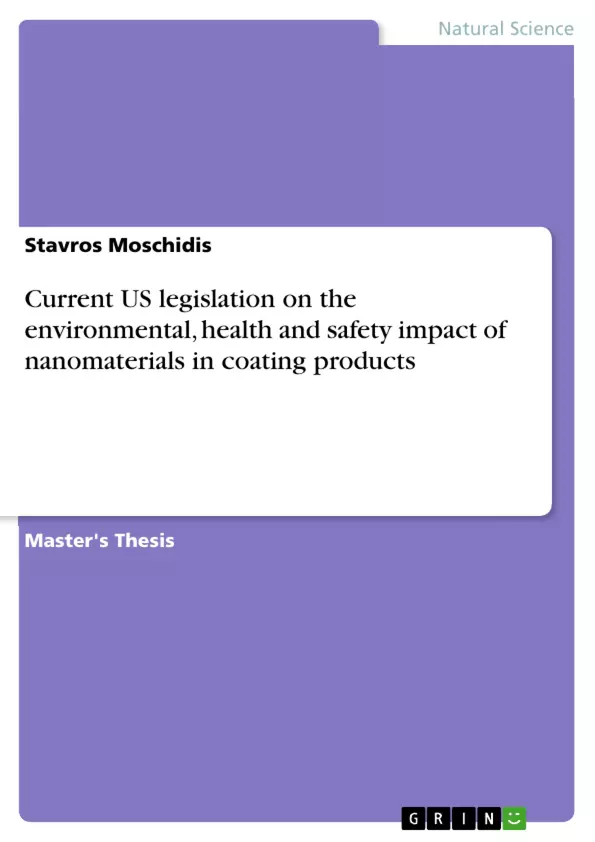This study represents an analysis of the ability of current US environmental, health and safety regulations at a federal level to manage the risk posed by nanomaterials in coating products.
Alongside the functional benefits from the use of nanomaterials in coating applications (e.g. antimicrobial, UV protection, anticorrosive, anti-scratch properties, etc.), there are concerns regarding the exposure of humans and the environment during the manufacture, processing, development, use and end of life stage of these materials. A life cycle paradigm is used, examining all regulations relevant to coating applications, identifying the issues in each regulatory framework but also, horizontal issues that govern all of them. This thesis makes an important contribution to the identification of which regulatory frameworks are the least
effective and whether any changes are required.
Inhaltsverzeichnis (Table of Contents)
- Abstract
- List of Tables
- List of Figures
- List of Abbreviations
- Acknowledgements
- Dedications
- 1. Introduction
- 1.1 Background of the study
- 1.1.1 Nanotechnology
- 1.1.2 Coatings
- 1.1.2.1 History of coatings
- 1.1.2.2 Nanocoating
- 1.1.3 Risk Regulations & Nanotechnology
- 1.2 Aim & Objectives of the Study
- 1.3 Boundaries of the study
- 2. Nanomaterials in Coatings in the USA Market
- 2.1 Nanomaterial Types Used in Coatings
- 2.2 Functional Benefits of Nanotechnology-based Coatings
- 3. Risks Posed by Coatings containing Nanomaterials
- 3.1 Hazards of Nanomaterials used in Coatings
- 3.2 Potential Releases
- 3.2.1 Potential Releases from the Nanomaterial Manufacturing Stage
- 3.2.2 Potential releases during the Material Processing Stage & NM-Coating Manufacturing
- 3.2.3 Potential Release of NMs from Coating Applications during Use Stage
- 3.2.4 Potential Release during the Incineration, Land-filling & Waste Water Treatment Stage
- 4. Life Cycle Regulations of Nanocoatings
- 4.1 Horizontal Issues across all Regulations
- 4.1.1 Absence of Nano-Definition
- 4.1.2 Failure of Reporting of Nanomaterials in Commercial Use and Fuzzy Commercialization Paths
- 4.1.3 No Standardized Methods
- 4.1.4 Poor Risk Communication
- 4.2 Pre-market Stage Regulations
- 4.2.1 TSCA Regulatory Issues
- 4.2.1.1 No Toxicity Test Requirements for Submission by the Manufacturers/Importers
- 4.2.1.2 Exposure data
- 4.2.1.3 Chemical Substance Inventory Issue
- 4.2.1.4 Premanufacture Notification Issue
- 4.2.1.4.1 No Impurity Cut-offs
- 4.2.1.5 TSCA Exemptions Issues
- 4.2.1.5.1 Low Volume Exemption (LVE)
- 4.2.1.5.2 Low Risk of Exposure Exemption (LoREx)
- 4.2.1.5.3 Polymer Exemption Rule
- 4.2.2 Ineffective Characterization at Different Life Cycle Stages
- 4.2.2.1 Proposed Rule for Nanoscale Materials: TSCA Reporting and Recordkeeping Requirements
- 4.2.2.1.1 Substances excluded from reporting
- 4.2.3 Federal Insecticide, Fungicide, and Rodenticide Regulatory Issues
- 4.3 Use Stage Regulations
- 4.3.1 Consumer Product Safety Act Issues
- 4.4 End of Life Regulations
- 4.4.1 Resource Conservation and Recovery Act Issues
- 4.4.1.1 Data & Uncertainty
- 4.4.1.2 Problematic Exemptions
- 4.4.2 The Comprehensive Environmental Response, Compensation, and Liability Act Regulatory Issues
- 4.5 Regulations along Lifecycle
- 4.5.1 OSHAct Issues
- 4.5.2 Clean Air Act & Clean Water Act Issues
- 5. Analysis & Discussion
- 5.1 Analysis
- 5.2 Discussion
- 6. Conclusions
- 7. References
Zielsetzung und Themenschwerpunkte (Objectives and Key Themes)
This dissertation aims to analyze the effectiveness of current US environmental, health, and safety regulations at a federal level in managing the risks posed by nanomaterials in coating products. The study focuses on identifying regulatory gaps and shortcomings specific to nanomaterials in coatings, highlighting cross-cutting issues across different regulatory frameworks. It also seeks to determine the adequacy of each regulatory framework in addressing environmental, health, and safety concerns throughout the lifecycle of these materials.
- Regulatory shortcomings specific to nanomaterials in coating products
- Cross-cutting issues across different regulatory frameworks
- Adequacy of regulatory frameworks for managing EHS concerns throughout the lifecycle of nanomaterials in coatings
- Potential for exposure to nanomaterials from various sources
- Challenges in gathering and utilizing data for risk assessment and management
Zusammenfassung der Kapitel (Chapter Summaries)
Chapter 2 explores the types of nanomaterials used in coatings and the functional benefits they provide. It delves into the diverse range of applications for these coatings and their significance in various industries.
Chapter 3 investigates the potential risks posed by coatings containing nanomaterials, analyzing release scenarios throughout the product lifecycle. It discusses the inherent characteristics of nanomaterials that make them distinct from their larger counterparts, potentially leading to different environmental and health effects.
Chapter 4 presents a detailed review of the US regulatory landscape relevant to coating applications. It identifies specific issues within each statute, particularly the Toxic Substances Control Act (TSCA), and discusses cross-cutting issues impacting the entire regulatory framework.
Chapter 5 analyzes the effectiveness of each regulatory framework in managing the safety of nanomaterials in coating products, applying specific criteria such as nanomaterial coverage, risk review triggers, availability of toxicity and exposure data, and risk communication effectiveness. The chapter identifies which regulatory frameworks are least effective and highlights the need for potential amendments.
Schlüsselwörter (Keywords)
The primary focus of this dissertation revolves around the adequacy of current US legislation in managing the environmental, health, and safety of nanomaterials, specifically those used in coating products. Key themes include nanomaterials in coatings, regulatory frameworks, risk assessment, exposure pathways, and the challenges of managing emerging technologies with limited scientific data.
- Arbeit zitieren
- Stavros Moschidis (Autor:in), 2015, Current US legislation on the environmental, health and safety impact of nanomaterials in coating products, München, GRIN Verlag, https://www.grin.com/document/312477



